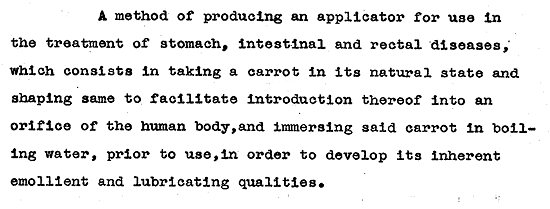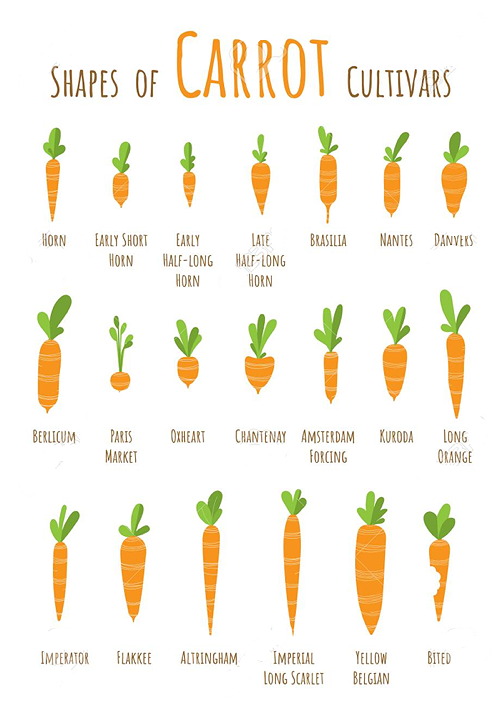The Patented Carrot Rectal Dilator
In 1927, the Canadian patent office granted an unusual patent (CA 259317) to George L. Kavanagh. It was unusual because, while most patents describe some new type of gadget or gizmo, Kavanagh's invention simply consisted of a method of using a carrot.
The problem Kavanagh had set out to solve was that of constipation in the elderly. The way he saw it, our rectums tend to grow more inelastic and shrunken as we age, and this leads to constipation. The solution, he concluded, was "gently dilating the anus and rectum until the organs are restored to their youthful size."
But what could be used as a dilator? Preferably something inexpensive and readily obtainable. That made him think of carrots.
A summary from his patent:

An added benefit of carrots, he noted, was that they come in a variety of different sizes. This would allow one to start with small carrots and work up to larger ones "until the desired result is obtained."
Unfortunately, Kavanagh submitted no drawings with his patent. But I did find a chart that provides a size comparison of different types of carrots, which could be potentially useful for anyone who wants to try out Kavanagh's method at home on an elderly relative.

Update: Kavanagh also got a US Patent (No. 1,525,505) for his invention.
The problem Kavanagh had set out to solve was that of constipation in the elderly. The way he saw it, our rectums tend to grow more inelastic and shrunken as we age, and this leads to constipation. The solution, he concluded, was "gently dilating the anus and rectum until the organs are restored to their youthful size."
But what could be used as a dilator? Preferably something inexpensive and readily obtainable. That made him think of carrots.
A summary from his patent:

An added benefit of carrots, he noted, was that they come in a variety of different sizes. This would allow one to start with small carrots and work up to larger ones "until the desired result is obtained."
Unfortunately, Kavanagh submitted no drawings with his patent. But I did find a chart that provides a size comparison of different types of carrots, which could be potentially useful for anyone who wants to try out Kavanagh's method at home on an elderly relative.

image source: 123rf.com
Update: Kavanagh also got a US Patent (No. 1,525,505) for his invention.
Comments
So many mental pictures. I can't imagine being on the giving or receiving end of the treatment.
Posted by KDP on 11/24/21 at 10:06 AM
There's an old meme (don't Google it with 'safe search' disabled) says "The only difference between a good meal and a good time is where you put the cucumber." I guess this is the same principle, just a different veggie.
Posted by Phideaux on 11/24/21 at 01:02 PM
I wonder, does it make a difference whether you use an orange carrot, a purple one, a yellow one or a red one? 'Cause my favourite market grocer sells all of those in various sizes...
Posted by Richard Bos on 11/27/21 at 04:47 AM
Commenting is not available in this channel entry.

Category: Health | Inventions | Patents | Vegetables | 1920s